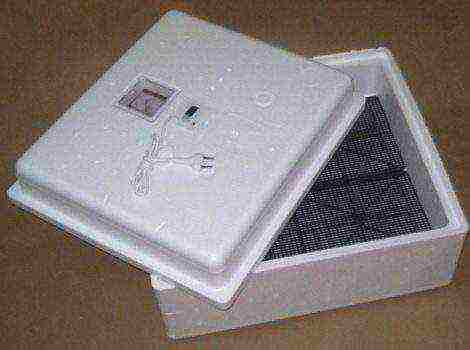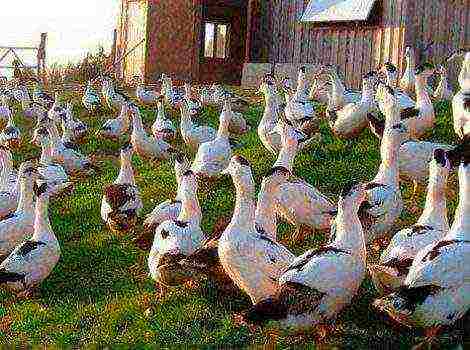Content
Symptoms and treatment of infectious and other diseases of chickens
Breeding and keeping domestic chickens is a fascinating and profitable activity. But they may develop pathologies and diseases for which prevention can be carried out. If nevertheless appeared symptoms of the disease, then you should correctly establish the diagnosis and engage in surgical treatment.
Symptoms of chicken diseases
Sneezing chickens
May be a symptom of a viral infection (contagious rhinitis, tuberculosis, colds, infectious bronchitis, mycoplasmosis). Treatment of symptoms is carried out by warming chicken coops, watering birds with a decoction of nettle, and inhalation. Infectious chicken bronchitis is eliminated with disinfectants (aluminum iodide, Glutek aerosol, Lugol's solution, chloro turpentine). Antibiotics are also used.

Cough
May appear when infected with wormstherefore a parasite remedy should be given. If the birds do not have worms, then prophylactic therapy is carried out. Cough can be a symptom of hypothermia, infectious bronchitis, bronchopneumonia, mycoplasmosis, colibacillosis. In addition to bronchitis diseases, a cough may indicate other pathologies. Often a cough appears when new individuals arrivewho are infected with an infection. Treatment methods - nettle decoction or inhalation with drugs. Prescribe tetracycline, furazalidone, which are added to drinking water.
Wheezing
Wheezing is uncommon for breathing in healthy chickens.... They are often manifested in colds and bronchial diseases (bronchopneumonia, infectious bronchitis), colibacillosis. The chicken is breathing heavily, wet and dry wheezing appears in the sternum area.
Diarrhea in birds
It can manifest itself as a result of colds, poor-quality food, gastritis, stress, pulloza, worms, coccidiosis, pasteurellosis, salmonellosis, bird flu. In laying hens, a nervous breakdown is possible with fright, a change in the environment and can pass in a day. If the bird begins to cough with colds due to hypothermia, it is transferred to a warm room. Poor quality feed is excluded. For the treatment of ailments the diagnosis should be accurately determined; self-medication should not be prescribed.
Runny nose
Birds runny nose may appear as a result of damage by pathogenic fungi, bacteria, worms, coccidiosis and other serious pathologies (infectious bronchitis, smallpox, fodder diphtheria). The cause of the appearance of pathology there may be a lack of vitamin A, a change in diet, a change in temperature, poor ventilation.
Diseases of the legs in chickens: growths on the legs, lameness and more
There are many causes of leg diseases in chickens.... With their improper maintenance, lack of space, mobility decreases, due to which the musculoskeletal system is impaired and the chickens begin to limp. Pathologies of the legs include gout, curvature of the fingers, joint diseases (tendovanginitis, arthritis and arthrosis), knemidocoptosis.Also, the symptom may be a sign of salmonellosis.
Why chickens can go blind
The bird may go blind as a result of damage to sinusitis, panophthalmitis, inflammation of the conjunctiva. To eliminate this symptom, antibiotic treatment is prescribed.
Infectious diseases, signs and treatments
Many bird diseases are easier to prevent than to cure. Why can chickens still get sick? It is recommended to create appropriate conditions for chickens with optimal care... They are provided with the correct temperature and light conditions, timely nutrition, and hygiene of the chicken coop. But even in excellent conditions of detention, there is no one hundred percent protection against the appearance of pathologies. Most infections develop as a result of stress, lack of movement, metabolic disorders and daily routine. The health of chickens is also subject to change under the change of climatic zone.
To maintain health and prevent the occurrence of infections, the chicken coop must be kept clean, take care of your own hygiene. It is important to correctly identify the symptoms of diseases for the correct treatment of infections..
Pullorosis typhoid
Pathology manifests itself in adult and young birds, manifests itself as upset of the gastrointestinal tract. Bacteria, causative agents of infection, are transmitted by airborne droplets from affected eggs and sick individuals. It appears profuse diarrhea, great thirst, lack of appetite, general weakness and rapid breathing. A pullor antigen is used to determine the disease. With an accurate determination of the pathogen, antibiotics are prescribed (neomycin, biomycin) and isolation from healthy individuals.

Colibacillosis
It manifests itself in young and adults in the form of fever, thirst and lethargy. The infection affects the respiratory tract, as a result of which wheezing appears, which will increase with movement. But pathology is not always detected by wheezing; the help of a specialist may be required. The causative agent is Escherichia colithat affects the internal organs.
After determining the diagnosis, treatment is prescribed - Penicillin, biomycin or terramycin is introduced, multivitamins are added to the feed, only nutritious and fresh grain is recommended.
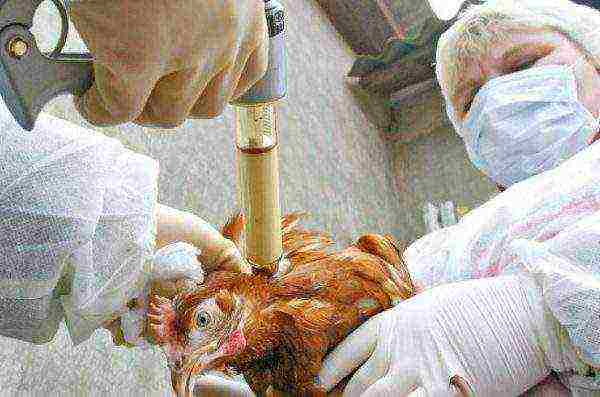
Pasteurellosis
The pathology manifests itself in wild and domestic birds. The pathogen can be in food, water, manure for a long time, it is transmitted to healthy individuals from infected individuals. Prophylaxis - do regular cleaning and disinfection of the house.
The symptom of pathology is blue discoloration of the scallop and earrings, lethargy, lack of appetite, intense thirst, indigestion, high fever and mucus in the nose. In the acute form of pathology swelling or curvature of the paw joints may appear.
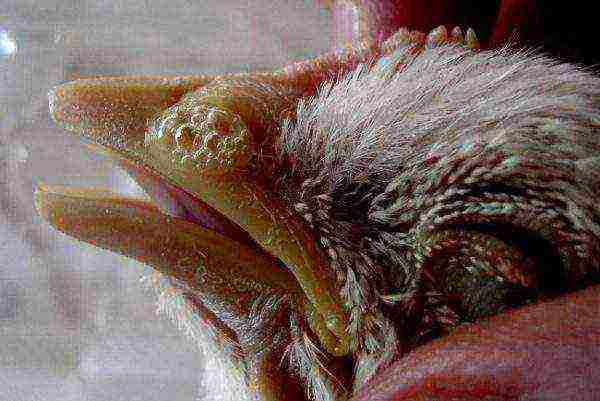
Treatment is based on the use of sulfa drugs and their addition to feed, water. Also, the birds are given vitamins E, B, A and fresh herbs. If left untreated, the livestock dies.
Salmonellosis
Basically manifests itself in young individuals in the form of conjunctevitis, lameness, shortness of breath, high lacrimation. With an advanced form of the disease chickens fall on their side and die. Antibiotic treatment (sulfonamide, chlortetracycline, chloramphenicol) should not be delayed by adding small doses to the feed for about 2 weeks.
Newcastle disease (pseudo plague)
Pathology is characterized by acute dysfunction of the nervous system, digestive organs. Spread from birds and animals that were previously sick, through their water, feed and droppings, is not treatable. After the defeat of the birds, their death is observed, which can destroy all individuals.
Chicken pox
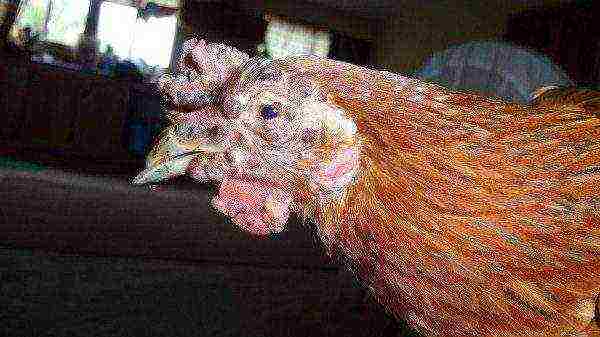
Affects young birds more often, manifested by growths-pockmarks on the skin in the area of the cloaca or head... At first they have a yellow tint, but gradually darken.In the absence of immediate treatment, the growths can join, increasing in size. They begin to bleed, harden and dry out.
Helminthic parasites in birds, how to treat
Worms (helminthic parasites) exist and feed on the host. Almost all bird diseases are associated with worms, since their larvae are everywhere. The main symptoms of pathology include weakness, indigestion, lack of appetite and severe weight loss. Treatment of helminths similar to the use of preventive measures. At the same time, the poultry house is cleaned, high-quality and fresh feed, special preparations are selected.
Non-communicable diseases, home treatment methods
Sometimes poultry can be exposed to diseases that are not inherently contagious. But from them there is no less harm than from infection. They do not have a specific pathogen and are mainly interconnected with inappropriate care of chickens, the wrong choice of feed, mechanical damage, trauma.
Atony of goiter in layers
Pathology manifests itself only in layers, the cause of which is an irregular or unbalanced diet, poor quality formulations that can accumulate in the goiter, forming an obstruction. The disease is easily determined by palpation of the goiter, which hangs down for a long time and is dense. In the absence of immediate assistance, the chicken dies instantly and abruptly.as the goiter obstructs the jugular vein and airways.
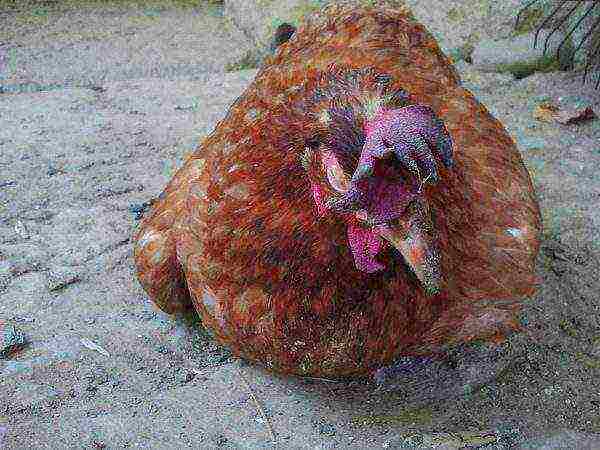
One of the methods of treatment is the use of a probe, into which a couple of milliliters of vegetable oil is dripped, massaged the hard goiter and turn the bird upside down, gradually removing the contents. After the procedure, it is advisable to pour a solution of potassium permanganate into the goiter.
Gastroenteritis (intestinal flu)
It manifests itself as a result of eating poor-quality feed, untimely feeding... With the appearance of pathology, weakness, indigestion and loss of appetite appear in birds. For the prevention and treatment of the disease, the causes are eliminated, rapidly digestible feed, laxatives and antibiotics are introduced into the diet.
Dyspepsia
This is a simple indigestion that occurs in juveniles that are 21 days old. The reason for the violation is the use of rough and poorly digested food, poor quality and contaminated water. It can be acute or chronic, characterized by high fever, lack of appetite, bloating, cramps, and diarrhea. Eliminate pathology with a diet with foods that do not lead to rotting and fermentation.
Cloacite
The disease manifests itself in individuals that eat food with a lack of vitamins and mineral salts. The provocateur of the development of pathology is inappropriate keeping of birds. Layers often get sick from cloacite, they suffer from a decrease in weight, number of eggs, and intestinal upset. When treating laying hens, it is necessary to separate from the flock, rinse the inflamed areas of the cloaca with a solution of rivanol, lubricating with a special compound.
Bronchopneumonia or pneumonia
Appears when chicken care is violated. Pathology manifests itself in young individuals under the age of 20 weeks with hypothermia. Symptoms are low mobility, severe wheezing, and loss of appetite. For treatment, antibiotics are used in individual dosages.
Keratoconjunctivitis - eye disease, how to cure
The disease affects poultry kept in sheds where there is no timely cleaning of droppings and cleaning... Fresh droppings are a source of ammonia, the vapors of which penetrate the bronchial passages and cause eye inflammation.Pathology can be identified by wet, dirty plumage, watery eyes, yellow clusters on the eyelids. When the pathogen is eliminated, the sheds are cleaned of droppings and the eyes are treated with a decoction of chamomile.
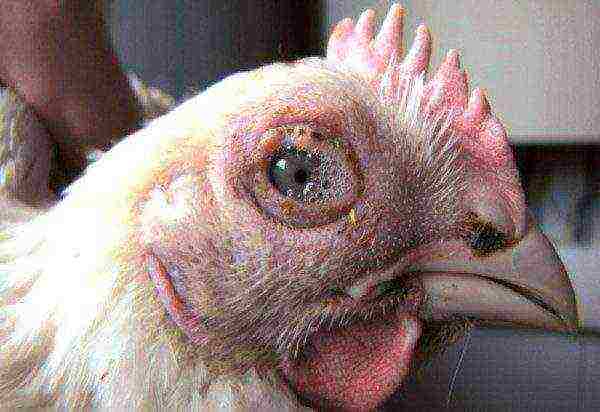
Avitaminosis
Often, the disease manifests itself in layers kept in cages for which mixtures are used. Vitamin deficiency symptoms are lack of weight, conjunctevitis, loss of feathers, weakness.
Diseases caused by insects, what to do?
Diseases caused by insects, belong to a separate section. Due to the variety of symptoms, it is possible not to make a definite diagnosis, therefore, the treatment of pathologies is difficult.
- Down-eaters, feather-eaters... Parasites damage feather rods, leave small holes in them, so chickens begin to itch and shed. For the treatment of the pathogen aerosol treatment and wood ash are used.
- Fleas... If fleas appear in the nests, then the chickens become restless, do not want to sit on the clutches. Insecticidal treatment of the chicken coop should be carried out, the litter should be changed regularly.
- Mites... The symptom of their appearance is the loss of feathers. Ticks cannot be fought and chickens must be killed.
- Lice or bedbugs... Parasites live in nests, chicken coops and bodies of birds, feeding on their blood. To eliminate insects, poultry houses are regularly treated with chlorophos, karbofos.
- Chickens can also be affected ringworm, aspergillosis.
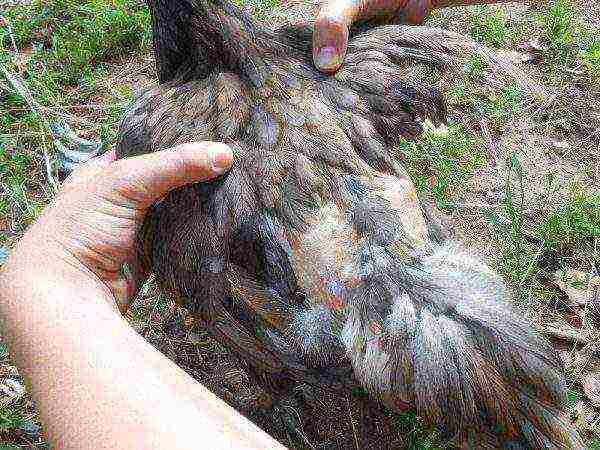
If you do not want to lose chickens, then you should periodically take preventive measures, separating sick individuals from healthy ones, destroying those who cannot be cured. Treat the house with disinfectants every 30 days... Birds need to be provided with proper care, a balanced diet.

